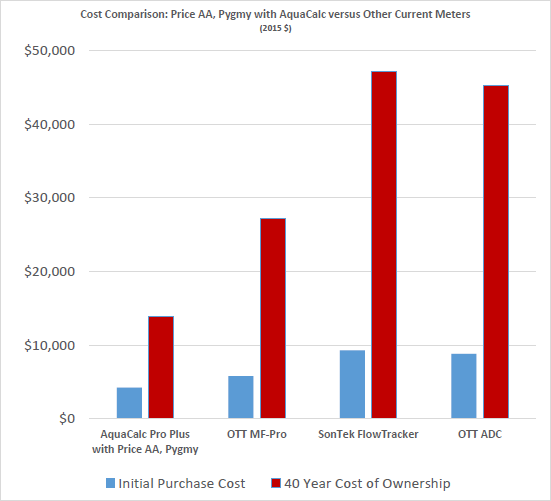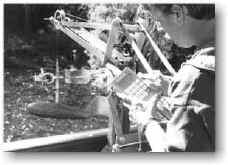 Loading... Please wait...
Loading... Please wait...Hydrological Equipment
NEWS RELEASE
Cost and Accuracy Comparisons

Mechanical Current Meter System with AquaCalc Versus Other Point Velocity Discharge Systems
Download PDF
Stream Gaging Instruments
 Stream Gaging is the common term for measuring the amount of water flowing in an open channel and can range from a trickle in a ditch to a flood on the Amazon River. The U.S. Geological Survey (USGS) makes most streamflow measurements by current meter. A current meter is an instrument used to measure the velocity of flowing water. The principle of operation is based on the proportionality between the velocity of the water and the resulting angular velocity of the meter rotor. By placing a current meter at a point in a stream and counting the number of revolutions of the rotor during a measured interval of time, the velocity of water at that point is determined.
Stream Gaging is the common term for measuring the amount of water flowing in an open channel and can range from a trickle in a ditch to a flood on the Amazon River. The U.S. Geological Survey (USGS) makes most streamflow measurements by current meter. A current meter is an instrument used to measure the velocity of flowing water. The principle of operation is based on the proportionality between the velocity of the water and the resulting angular velocity of the meter rotor. By placing a current meter at a point in a stream and counting the number of revolutions of the rotor during a measured interval of time, the velocity of water at that point is determined.
Current meters generally can be classified into two main types, those meters having vertical-axis rotors and those having horizontal-axis rotors. The comparative characteristics of these two types are summarized below:
Vertical-axis rotor with cups
- Operates in lower velocities than do horizontal-axis meters.
- Bearings are well-protected from silty water.
- Rotor is repairable in the field without adversely affecting the rating.
- Single rotor serves for the entire range of velocities.
Horizontal-axis rotor with vanes
- Rotor disturbs flow less than do vertical-axis rotors because of axial symmetry with flow direction.
- Rotor is less likely to be entangled by debris than are vertical-axis rotors.
The current meters selected by the USGS for their standard use has been the Price Type AA and pygmy vertical axis current meters. Through extensive testing and research, this style meter has proven itself a highly accurate, durable, low maintenance and economical choice for stream velocity measurements. The equipment described here was designed to support current meter measurements by wading off a bridge, boat or cableway. Support equipment such as taglines, wading rods, and sounding reels take measurements of the physical stream size thus allowing the computation of total flow or discharge by Q=VxA where Q is total flow in CFS or CMS, V is the velocity in FPS or MPS and A the area in square feet or meters.
Also offered are the Ott-type horizontal axis current meters which were developed and are primarily used in Europe. This horizontal axis style meter offers the ability to measure oblique current velocities with different pitch rotors available. The USGS does not use the Ott-type meter because it is not as durable as the Price meter under extreme conditions and requires more preparation and care to operate than the Price-type meter.
Two different ultrasonic Doppler or acoustic type velocity meters are available for field use for portable and permanent field installation. These systems are used in extremely low reversing flow conditions or in extreme flood conditions where a current meter cannot be put in the water.
